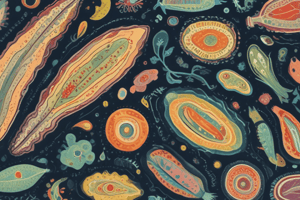Podcast
Questions and Answers
Why are protists difficult to classify?
Why are protists difficult to classify?
Their relationships to each other are often difficult to determine.
How do protists obtain food?
How do protists obtain food?
Eating other organisms, photosynthesis, decomposing.
Which protists have chlorophyll?
Which protists have chlorophyll?
Plant-like.
Which protists move with pseudopodia?
Which protists move with pseudopodia?
Which protists move with cilia?
Which protists move with cilia?
Which protist has both an eyespot and flagella?
Which protist has both an eyespot and flagella?
What was the Great Potato Famine and where did it occur?
What was the Great Potato Famine and where did it occur?
What protist causes malaria and how is it transmitted?
What protist causes malaria and how is it transmitted?
What are protozoa?
What are protozoa?
Which protists cause a red tide?
Which protists cause a red tide?
What is a lichen?
What is a lichen?
Name two types of fungus-like protists.
Name two types of fungus-like protists.
What is the more common name for red, green, and brown algae?
What is the more common name for red, green, and brown algae?
What is a ciliate?
What is a ciliate?
What causes ringworm and athlete's foot?
What causes ringworm and athlete's foot?
What is the major difference between animals and animal-like protists?
What is the major difference between animals and animal-like protists?
Which type of protists are heterotrophic?
Which type of protists are heterotrophic?
What protein is in the cell wall of fungi?
What protein is in the cell wall of fungi?
Which kingdom is called the misfit kingdom and why?
Which kingdom is called the misfit kingdom and why?
Plantlike protists reproduce in what two ways?
Plantlike protists reproduce in what two ways?
In which kingdom are truffles located and what is the unusual way they are found?
In which kingdom are truffles located and what is the unusual way they are found?
Name three common fungi.
Name three common fungi.
Flashcards are hidden until you start studying
Study Notes
Classifying Protists
- Protists are challenging to classify due to complex relationships that are hard to define.
- Protists can obtain food by consuming other organisms, through photosynthesis, or by decomposing organic matter.
- Plant-like protists possess chlorophyll, enabling photosynthesis.
- Amobas are known for their movement using pseudopodia.
- Animal-like protists use cilia for movement.
- Euglena, a unique protist, has both an eyespot and flagella for light detection and movement.
Historical Impact of Protists
- The Great Potato Famine occurred in Ireland; a fungus caused widespread rot in potatoes, leading to a devastating food shortage.
- Malaria is caused by the protist Plasmodium, which is transmitted through mosquito bites.
Types and Functions of Protists
- Protozoa are classified as animal-like protists.
- Dinoflagellates are known for causing red tides.
- Lichens represent a mutualistic relationship between fungi and algae or photosynthetic bacteria.
- Slime molds and water molds are examples of fungus-like protists.
- Red, green, and brown algae are collectively known as seaweed.
Fungi Characteristics
- Ciliates are a type of protozoa characterized by their cilia.
- Fungi are responsible for diseases like ringworm and athlete's foot.
- The primary distinction between animals and animal-like protists is that animal-like protists are single-celled.
- Animal-like protists are heterotrophic, meaning they cannot produce their own food and rely on other organisms.
- Fungi have cell walls composed of chitin, which distinguishes them from plant cells.
Kingdom Protista
- The Protista kingdom is often referred to as the "misfit kingdom" due to its vast diversity.
- Plant-like protists can reproduce both sexually and asexually.
Unique Fungal Characteristics
- Truffles are found in the Fungi kingdom and are uniquely located by animals such as pigs and dogs using their sense of smell.
- Common types of fungi include mushrooms, truffles, and yeast.
Review Structure
- Study materials may include various formats such as 10 true/false questions, 10 fill-in-the-blank questions, and 5 multiple-choice questions.
Studying That Suits You
Use AI to generate personalized quizzes and flashcards to suit your learning preferences.




